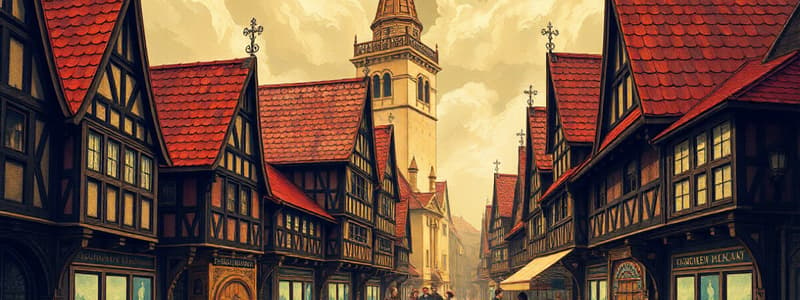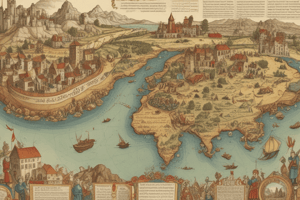Podcast
Questions and Answers
Wealthy merchants often had splendid ______.
Wealthy merchants often had splendid ______.
homes
The family's living quarters might be on the second level, complete with a ______.
The family's living quarters might be on the second level, complete with a ______.
solar
Even for wealthy families, life was not always ______ compared to life today.
Even for wealthy families, life was not always ______ compared to life today.
comfortable
Fireplaces were considered the main source of ______ and light.
Fireplaces were considered the main source of ______ and light.
About half of all children died before they became ______.
About half of all children died before they became ______.
Boys and girls who attended school learned to ______ and write.
Boys and girls who attended school learned to ______ and write.
Most girls married young, usually around the age of ______.
Most girls married young, usually around the age of ______.
What brought most people to towns was ______—meaning trade and commerce.
What brought most people to towns was ______—meaning trade and commerce.
At the beginning of the Middle Ages, most trade was in ______ goods.
At the beginning of the Middle Ages, most trade was in ______ goods.
By the High Middle Ages, more local people were buying and selling everyday goods like food, clothing, and ______ items.
By the High Middle Ages, more local people were buying and selling everyday goods like food, clothing, and ______ items.
Most towns had a ______, where food and local goods were bought and sold.
Most towns had a ______, where food and local goods were bought and sold.
Merchant guilds came to dominate the ______ life of towns and cities.
Merchant guilds came to dominate the ______ life of towns and cities.
In Christian Europe, Jewish communities faced deep ______ and prejudice.
In Christian Europe, Jewish communities faced deep ______ and prejudice.
One opportunity that was open to Jews was to become ______ and moneylenders.
One opportunity that was open to Jews was to become ______ and moneylenders.
Medieval towns were typically small and ______.
Medieval towns were typically small and ______.
Flashcards
Medieval trade growth
Medieval trade growth
Trade and commerce expanded dramatically in the High Middle Ages, moving beyond luxury goods to include everyday items like food and clothing.
Specialized towns
Specialized towns
Medieval towns often focused on producing specific goods, such as cloth, glass, or silk.
Merchant fairs
Merchant fairs
Large gatherings that brought together merchants from various countries, fostering trade across Europe and beyond.
Merchant guilds
Merchant guilds
Signup and view all the flashcards
Jewish moneylenders
Jewish moneylenders
Signup and view all the flashcards
Medieval town housing
Medieval town housing
Signup and view all the flashcards
Wealth inequality
Wealth inequality
Signup and view all the flashcards
Medieval houses and work
Medieval houses and work
Signup and view all the flashcards
Medieval Homes
Medieval Homes
Signup and view all the flashcards
Medieval Family Life
Medieval Family Life
Signup and view all the flashcards
Medieval Children's Education
Medieval Children's Education
Signup and view all the flashcards
Medieval Child Mortality
Medieval Child Mortality
Signup and view all the flashcards
Medieval Living Conditions
Medieval Living Conditions
Signup and view all the flashcards
Medieval Apprenticeships
Medieval Apprenticeships
Signup and view all the flashcards
Medieval Social Roles
Medieval Social Roles
Signup and view all the flashcards
Study Notes
Trade and Commerce in Medieval Towns
- Early trade focused on luxury goods, accessible only to the wealthy.
- By the High Middle Ages, more everyday goods were traded.
- Towns specialized in producing specific items (e.g., wool, glass, silk).
- Markets and larger fairs facilitated trade, attracting merchants from across Europe, the Middle East, and beyond.
- Merchants gained significant wealth and power, forming guilds that dominated town business.
- Merchants often held positions in town councils or served as mayors in independent towns.
- Jewish communities faced prejudice and discrimination in Christian Europe.
- Jewish people were often excluded from land ownership and were victims of violence.
- Charging interest on loans was often considered sinful (to Christians) leading Jewish people to play a vital role as bankers and moneylenders.
Homes and Households in Medieval Towns
- Medieval towns were small and densely populated.
- Houses were narrow and often multi-storied, predominantly constructed from wood.
- Homes could lean substantially due to their wood construction.
- Rich and poor lived in vastly different housing conditions; wealthy had many rooms and multiple levels.
- Poorer households often shared houses with multiple families, with only a single room.
- Work was often integrated into the home; a weaver's loom, for example, might be in the home.
- Wealthy homes had business areas in ground level, family areas (solar) upstairs, and even levels for servants and apprentices.
- Living conditions, even for the wealthy contrasted with modern standards. Heat and light came mainly from fireplaces, making homes cold, smoky, and dimly lit.
- Windows were small and often covered with parchment.
- High child mortality rate affected many families.
- Children's education and roles varied based on family wealth.
- Most children started working around age seven, and children from richer families might learn skills like painting or musical instruments.
- Medieval society emphasized order and traditional roles. Boys usually followed in their fathers' footsteps, girls often married young, and learned skills about the home from an early age.
Studying That Suits You
Use AI to generate personalized quizzes and flashcards to suit your learning preferences.
Description
Explore the dynamics of trade and commerce in medieval towns, focusing on the evolution of goods exchanged, the importance of markets and fairs, and the role of merchants and guilds. Delve into the social challenges faced by different communities, particularly the Jewish populations, and the impact on economic systems during this era.




